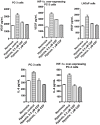Hypoxia induced aggressiveness of prostate cancer cells is linked with deregulated expression of VEGF, IL-6 and miRNAs that are attenuated by CDF
- PMID: 22952749
- PMCID: PMC3428287
- DOI: 10.1371/journal.pone.0043726
Hypoxia induced aggressiveness of prostate cancer cells is linked with deregulated expression of VEGF, IL-6 and miRNAs that are attenuated by CDF
Abstract
Tumor hypoxia with deregulated expression of hypoxia inducing factor (HIF) and its biological consequence leads to poor prognosis of patients diagnosed with solid tumors, resulting in higher mortality, suggesting that understanding of the molecular relationship of hypoxia with other cellular features of tumor aggressiveness would be invaluable for developing newer targeted therapy for solid tumors. Emerging evidence also suggest that hypoxia and HIF signaling pathways contributes to the acquisition of epithelial-to-mesenchymal transition (EMT), maintenance of cancer stem cell (CSC) functions, and also maintains the vicious cycle of inflammation, all of which contribute to radiation therapy and chemotherapy resistance. However, the detailed mechanisms by which hypoxia/HIF drive these events are not fully understood. Here, we have shown that hypoxia leads to increased expression of VEGF, IL-6, and CSC marker genes such as Nanog, Oct4 and EZH2, and also increased the expression of miR-21, an oncogenic miRNA, in prostate cancer (PCa) cells (PC-3 and LNCaP). The treatment of PCa cells with CDF, a novel Curcumin-derived synthetic analogue previously showed anti-tumor activity in vivo, inhibited the productions of VEGF and IL-6, and down-regulated the expression of Nanog, Oct4, EZH2 mRNAs, as well as miR-21 under hypoxic condition. Moreover, CDF treatment of PCa cells led to decreased cell migration under hypoxic condition. Taken together, these results suggest that the anti-tumor effect of CDF is in part mediated through deregulation of tumor hypoxic pathways, and thus CDF could become useful for cancer therapy.
Conflict of interest statement
Figures






References
Publication types
MeSH terms
Substances
Grants and funding
LinkOut - more resources
Full Text Sources
Other Literature Sources
Medical
Research Materials

